Jeffrey D. Sachs is the Director of the Earth Institute and Quetelet Professor of Sustainable
Development at Columbia University. He is also Director of the UN Sustainable Development Solutions Network and Special Advisor to UN Secretary-General Ban Ki-moon.

Sustainable development is the central drama of our time. In many ways, humanity has squandered the time it once had to adjust to environmental realities. Now our backs are up against the wall. We are living in history, and our generation’s history is the threat of unprecedented, global-scale environmental catastrophe.
The starting point is our crowded planet. There are now 7.2 billion people in the world, roughly nine times the 800 million people estimated to have lived in 1750, at the start of the Industrial Revolution. The world population continues to rise rapidly, by around 75 million people per year. Soon enough, there will be eight billion by the 2020s, and perhaps nine billion by the early 2040s.
These billions of people are looking for their foothold in the world economy. The poor are struggling to find the food, safe water, healthcare, and shelter they need for mere survival. Those just above poverty are looking for improved prosperity and a brighter future for their children. Those in the high-income world are hoping that technological advances will offer them and their families even higher levels of well-being. It seems that the super-rich also jostle for their place in the world’s rankings of wealthiest individuals.
In short, 7.2 billion people are looking for economic improvement. They are doing so in a world economy that is increasingly interconnected through trade, finance, technologies, production flows, migration, and social networks. The scale of the world economy, now estimated to produce $ 90 trillion of output per year (gross world product, or GWP), is unprecedented. By crude statistics, the GWP measures at least 200 times larger than back in 1750. In truth, such a comparison is difficult to make, since much of the world economy today consists of goods and services that did not even exist 250 years ago.
The world economy is vast, growing rapidly (by three to four percent per year in scale), and highly unequal in the distribution of income within countries and between countries. Ours is a world of fabulous wealth and extreme poverty: billions of people enjoy longevity and good health unimaginable in previous generations, yet at least one billion people live in such abject poverty that they struggle for mere survival every day. The poorest of the poor face the daily life-and-death challenges of insufficient nutrition, lack of healthcare, unsafe shelter, and the lack of safe drinking water and sanitation.
The world economy is not only remarkably unequal, but also remarkably threatening to Earth itself. Like all living species, humanity depends on nature for food and water, materials for survival, and safety from dire environmental threats, such as epidemics and natural catastrophes. Yet for a species that depends on the beneficence of nature, or on what the scientists call “environmental services,” we are doing a poor job of protecting the physical basis of our very survival! The gigantic world economy is creating a gigantic environmental crisis, one that threatens the lives and well-being of billions of people and the survival of millions of other species on the planet, if not our own.
The environmental threats are arising on several fronts. Humanity is changing Earth’s climate, the availability of fresh water, the oceans’ chemistry, and the habitats of other species. These impacts are now so large that Earth itself is undergoing unmistakable changes in the functioning of key processes—such as the cycles of water, nitrogen, and carbon—upon which life depends. We don’t know the precise scaling, timing, and implications of these changes, but we do know enough to understand that they are extremely dangerous and unprecedented in the span of humanity’s 10,000 years of civilization.
Changing Course
Thus we arrive at sustainable development. As an intellectual pursuit, sustainable development tries to make sense of the interactions of three complex systems: the world economy, the global society, and the Earth’s physical environment. How does an economy of 7.2 billion people and $ 90 trillion GWP change over time? What causes economic growth? Why does poverty persist? What happens when billions of people are suddenly interconnected through markets, technology, finance, and social networks? How does a global society of such inequality of income, wealth, and power function? Can the poor escape their fate? Can human trust and sympathy surmount the divisions of class and power? And what happens when the world economy is on a collision course with the physical environment? Is there a way to change course, a way to combine economic development with environmental sustainability?
Sustainable development is also a normative outlook on the world, meaning that it recommends a set of goals to which the world should aspire. The world’s nations will soon adopt Sustainable Development Goals (SDGs) precisely to help guide the future course of economic and social development on the planet. In this normative sense, sustainable development thus calls for a world in which economic progress is widespread; extreme poverty is eliminated; social trust is encouraged through policies that strengthen the community; and the environment is protected from human-induced degradation. Sustainable development recommends a holistic framework, in which society aims for economic, social, and environmental goals: SDGs call for socially inclusive and environmentally sustainable economic growth.
To achieve the economic, social, and environmental objectives of the SDGs, a fourth objective must also be achieved: good governance. Experience and common sense tell us that governments must carry out many core functions to enable societies to prosper. Among these core functions of government are the provision of social services such as healthcare and education; the provision of infrastructure such as roads, ports, and power; the protection of individuals from crime and violence; the promotion of basic science and new technologies; and the implementation of regulations to protect the environment. Of course, this list is just a brief subset of what people around the world hope for from their governments. In fact, all too often they get the reverse: corruption, war, and an absence of public services.
In our world today, good governance cannot refer only to governments. The world’s multinational companies are often the most powerful actors. Our well-being depends on these powerful companies obeying the law, respecting the natural environment, and helping the communities in which they operate, especially to help eradicate extreme poverty. Yet as with governments, reality is often the reverse. Multinational companies are often the agents of public corruption, bribing officials to bend regulations or tax policies in their favor and engaging in tax evasion, money laundering, and reckless environmental damage.
Thus the normative side of sustainable development envisions four basic pillars of a good society: economic prosperity; social inclusion and cohesion; environmental sustainability; and good governance by major social actors, including governments and business. It’s a lot to ask for, and there is no shortage of challenges to achieving sustainable development in practice.
Yet the stakes are high. Achieving sustainable development on our crowded, unequal, and degraded planet is the most important challenge facing our generation. The SDGs must be the compass, the lodestar, for the future development of the planet during the period from 2015 to mid-century.
The world’s governments, under the auspices of the United Nations, are currently attempting to negotiate a framework to help guide humanity through the very difficult environmental crises of our own making. 2015 is the most important year of diplomacy on sustainable development in decades. There are three mega-summits next year. The first is on Financing for Development, in Addis Ababa, Ethiopia, in July 2015. The next is to adopt the Sustainable Development Goals, at the UN headquarters in New York, in September 2015. The third is on climate change—the 21st Conference of Parties (COP21) of the UN Framework Convention on Climate Change—in Paris in December 2015. It is vital that these negotiations be successful, with the UN playing a central role in leading the world’s governments to set a global sustainable development framework and then to implement that framework in the decades to come.
The Anthropocene
We have entered a new environmental era on the planet, which Professor Paul Crutzen has helped to christen the Anthropocene. This new concept is deeply correct and, indeed, both startling and extremely important.
We are now in a human-driven physical world. Sometimes the scientists say that humans have become the main “drivers” of planetary-scale change, but if we’re “driving” we are certainly not paying attention to the wheel! The global economy is changing the planet in extraordinarily dangerous ways, and yet our political systems are displaying an almost complete inattention to these dangerous trends.
A statement of President John F. Kennedy, made half a century ago, still applies today. In his inaugural address, Kennedy said: “Man holds in his mortal hands the power to abolish all forms of human poverty and all forms of human life.” In essence, we are living in a time of extraordinary choice. Our technological capacity can be uniquely beneficial: we can end extreme poverty in this generation. Yet it can also be incredibly destructive, not only in the sense of the thermonuclear risk that President Kennedy referred to, but also to environmental destruction that threatens us in our generation.
How did we arrive at this dangerous point? We are the inheritors of two centuries of dramatic technological breakthroughs. Economic history shows an almost unchanging level and character of global economic activity over the course of centuries (even perhaps a couple millennia) up until around 1750. It is only in the last two and a half centuries that rapid economic growth in the modern sense has occurred, and this unprecedented economic growth has been the result of waves of technological change.
The biggest breakthrough came with James Watt (and his predecessor Thomas Newcomen), who first showed how to use fossil fuel—ancient solar energy stored in the form of coal, oil, and gas—for motive power. Watt’s steam engine and other fossil-fuel-using technologies that followed (e.g. the internal combustion engine and gas turbine) have fundamentally transformed the world economy, and now the planetary environment as well. Indeed, since Watt’s steam engine (in 1776), there have been a series of fundamental technological advances, sometimes called “Kondratieff waves” (Figure 1). For example, we are now living through the wave of the Digital Revolution, which is again reshaping the world economy.
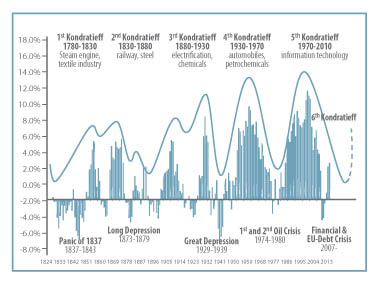 |
|
Figure 1: Kondratieff waves of technological transformation |
These waves of technology have shaped the modern world, and the growing human impact on the environment. The path of total world output is therefore unlike anything seen before the modern economic era. Figure 2 shows the best reconstruction we have of the long sweep of GWP. The essence of the picture is that history changed around 1800 (with the first Kondratieff wave and those that followed). Gross World Product has soared vertically, but we have not adjusted to this reality, either institutionally, morally, ethically, or cognitively. Yet this change has fundamental implications for how we live with each other and how we live with the planet.
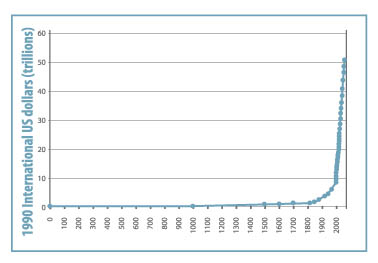 |
|
Figure 2: Soaring World Output |
The path of the global population (Figure 3) looks like almost the same curve as GWP, and it is indeed closely related.
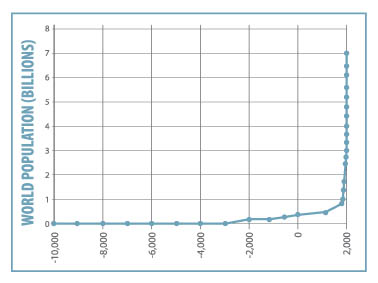 |
|
Figure 3: Growth of World Population |
For the long stretch of human history the global population remained virtually unchanged. The change over centuries was so small that it was nearly imperceptible to those who lived at any time in the preindustrial age (except of course for rare episodes such as the Black Death in Europe). Yet after 1800 or so, the world’s population began to soar. This is mainly (though not only) because the advances in global technology included the ability to grow vastly more foodstuffs to feed a growing world population. The result is that the global population has risen roughly eight-fold since 1800, from around 900 million to 7.2 billion people today.
Figure 4 shows another curve that looks similar. It is, indeed, another case of geometric growth.
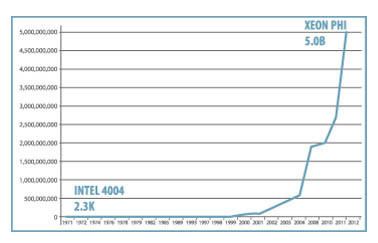 |
|
Figure 4: The Information Revolution: Moore’s Law |
This one is Moore’s Law, the doubling of the “transistor count” on advanced integrated circuits roughly every 24 months, a doubling process that has been occurring since the advent of integrated circuits around 1958. Moore’s Law describes our generation’s Kondratieff wave, the Digital Revolution. The ability to store, process and transmit data in bits has improved by roughly one billion times since 1959. This great advance in digital technology is already transforming the world economy, the nature of jobs, and the pursuit of science in almost every sphere.
The digital revolution gives us great technological power, both for good (to fight poverty) and alas also for bad (for example through more advanced spying or accelerated environmental catastrophe).
The cumulative result of the five Kondratieff waves is a fully interconnected world economy and global society. These interconnections are depicted graphically in Figure 5.
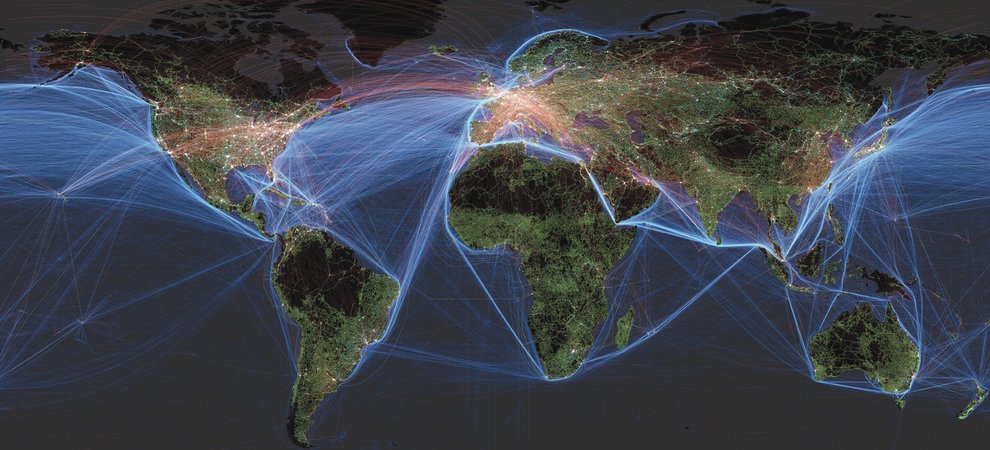 |
|
Figure 5: The Connected Global Economy. Photo: Globaia |
Transformative Ideas The white lines in the figure depict the global aviation routes; the blue lines depict the ocean-shipping lanes; and the green lines show the road networks. The bright white dots are major urban agglomerations. All in all, the world is deeply interconnected as never before. This is, of course, what is meant by “globalization” in our era.
There is, of course, much good news associated with this stunning technological progress. One piece of good news is that the global rate of extreme poverty has been falling significantly in the past two decades. China has been the greatest exemplar of that progress. China’s rate of extreme poverty, according to World Bank data, fell from around 60 percent in 1990 to around 12 percent in 2010. Overall headcount poverty (the proportion of households living below the World Bank’s poverty line) declined by more than half between 1990 and 2010, from around 43 percent at the start of the period to around 21 percent at the end of the period. This reduction of poverty represents a marvelous improvement in the quality of material life, and it is happening in many parts of the developing world, though most notably in Asia, and then in Africa since around 2000.
Yet the good news of economic advance is offset by considerable bad news as well. First, the economic progress has been unequal in its impacts and many technological changes have caused major shifts in the distribution of jobs and incomes. For example, the demand for unskilled labor seems to have declined markedly in the last 20 years. This is in turn leading to higher youth unemployment, falling incomes of young people, and rising social stresses in many parts of the world. Over the past few years, we have seen so many images of the police confronting young people in clashes in major cities all over the world. This unrest is becoming a nearly universal phenomenon.
The global environmental impacts of global economic development are probably even graver than the social dislocations. As the result of massive economic growth and the neglect of the physical environment, humanity is “trespassing” on a number of key Planetary Boundaries. The phrase Planetary Boundaries, coined in 2009 by a group of world-leading ecologists, signifies various environmental thresholds that humanity is crossing at great peril. These Planetary Boundaries are depicted in Figure 6.
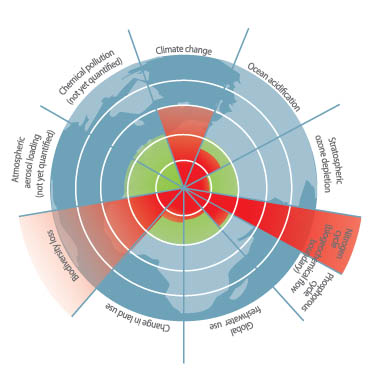 |
|
Figure 6: Planetary Boundaries |
They include human-induced climate change; human-induced acidification of the oceans; human-induced release of nitrogen and phosphorus into the environment (mainly from fertilizer use); massive freshwater depletion; massive deforestation and other land use changes; massive human-induced destruction of biodiversity; massive aerosol pollution (e.g. through burning of fossil fuels in major cities); and massive chemical pollution.
The economic growth curve has turned up so steeply, and our environmental neglect is so severe, that humanity is crossing the safety boundaries of the planet.
And the dangers are evident in every part of the planet. We remember what New York City looked like on the occasion of Super-Storm Sandy, which hit the northeast coast of the U.S. in late October 2012. Yet New York City’s flooding is not unique. Bangkok, Beijing, Belgrade and countless other cities have had similar massive floods in the past three years.
Consider also another planetary boundary: aerosol pollution. In January 2014, Beijing’s air became so polluted that breathing the air became a major health risk. The best advice to Beijing residents was, “Don’t breathe for the following three days!” The air in many Asian mega-cities is unsuitable for human health and safety. This air pollution can reduce life expectancy by several years.
We are also seeing growing evidence of eutrophication, the massive algal blooms (followed by hypoxic or “dead” zones) that result from the massive poisoning of rivers, estuaries, and coastlines by nitrogen and phosphorus fertilizers carried by rivers and groundwater from millions of farms to the coast. In November 2013, we saw what was by some measure the strongest land-falling tropical cyclone in modern history, Typhoon Haiyan of November 2013. This massive typhoon struck the Philippines and caused mass destruction, dislocation and loss of life. Such is our new world, one of increasingly frequent and intense climate-related catastrophes.
Another key kind of disaster is the massive and increasingly frequent droughts that are plaguing so much of Africa and the Middle East (as well as the U.S. state of California in recent years). Human-induced climate change seems to be contributing to falling precipitation and rising evapotranspiration in many parts of the world’s drylands. The result is drought and in severe cases, famine. These increasing droughts are hitting against rising populations in these very places. The result is like the crossing of two scissor blades: falling rainfall on one blade, and rising populations on the other. As with the blades of scissors, these contrasting trends are cutting society to the bone, threatening health, food security, and political stability. Many drylands—Somalia, Yemen, and Syria to name three cases—are already succumbing to chaos.
The Concept of Sustainable Development came to public awareness 27 years ago through the World Commission on Environment and Development, most often called the Brundtland Commission (after its chair, Gro Harlem Brundtland). The concept was then incorporated into the three multilateral environmental agreements reached at the Rio Earth Summit in 1992, on climate change, biodiversity and desertification. Yet the grim reality is that these three treaties have not worked. International law has not proven to be a match for the juggernaut of the world economy. In every environmental domain, we are by far worse off than we were in 1992.
When the world’s governments met in June 2012, on the 20th anniversary of the Rio Earth Summit, at a meeting known as the Rio+20 Summit, the main challenge facing the governments was how to bolster sustainable development. In the key conclusion of the Summit, the world’s governments called for a new set of SDGs to help guide the world during the next fifteen-year period from 2015 to 2030. One of the reasons for this interest in high-level SDGs was the relative success of another set of high-level goals, the Millennium Development Goals (MDGs), on which I’ve had the honor to advise former UN Secretary-General Kofi Annan and now UN Secretary-General Ban Ki-moon. The MDGs have played a critical role in drawing global attention to extreme poverty. The hope is that the SDGs will similarly draw the world’s attention to the dire challenges of sustainable development.
The key importance of the SDGs is that they are universal; they invite the entire global society to become engaged in the Earth’s future. The SDGs thus move us beyond the rarefied realm of global treaties—which involve mainly lawyers, diplomats, negotiators, and politicians—to the realm of global civil society.
Negotiations are now taking place on the content and means of implementation of the SDGs. Vuk Jeremić played a historic role in that process, as the President of the 67th Session of the UN General Assembly. It fell to him and his colleagues in the 67th Session to establish the working groups and procedures to negotiate the new goals and the modalities for putting them into action. That successful effort is now leading to the adoption of the SDGs by world leaders at the UN in September 2015.
I direct a process for Secretary-General Ban Ki-moon called the Sustainable Development Solutions Network (SDSN). The SDSN is a new global network of academia, civil society, and the private sector established by the Secretary-General to work with the UN and with national and local governments both to help set the SDGs and then to achieve them. The SDSN will continue work from 2015 to 2030, the period of the Sustainable Development Goals. I am delighted that Vuk Jeremić, President of CIRSD, is on the Leadership Council of SDSN, as are the members of the CIRSD Board.
As one early phase of the SDSN’s work, the SDSN Leadership Council has made a recommendation to the General Assembly and Secretary-General as to what the SDGs might be. The SDSN has recommended ten main goals:
• End extreme poverty
• Promote sustainable growth and jobs
• Education for all
• Social inclusion for all
• Health for all
• Sustainable agriculture
• Sustainable cities
• Sustainable energy and climate change
• Sustainable biodiversity
• Good governance and global partnership
Nothing about achieving global Sustainable Development will be easy. We are very close to losing the possibility of avoiding climate catastrophe. In 2010, the world’s governments agreed to take action to avoid a two degrees Celsius rise of mean temperature above the pre-industrial level. We already have a 0.9 degrees Celsius increase, roughly half way to the globally agreed limit. If we continue with business as usual, the world’s mean temperature is likely to rise by as much as between four to six degrees Celsius by the end of this century. This would likely prove to be calamitous. The only way to achieve the two degrees Celsius target will be through decisive cooperation among the world’s major economies. A recent report of the SDSN, called the Deep Decarbonization Pathways Project Report, shows how the two degrees Celsius goal can still be met, but only through a very deep and rapid transformation of the global energy system to low-carbon energy sources and uses.
The fact of the matter is that humanity is still rushing headlong towards multiple collisions with nature and with each other, within highly divided and unfair societies. And yet, we have the means to succeed; that is, to combine the end of poverty with social inclusion and environmental safety. The most essential quality for our survival will be a shared impulse to do the right thing: to protect each other and nature from our greed, scientific lack of understanding, and disregard and carelessness.
Simply speaking, sustainable development is the greatest, most complicated challenge humanity has ever faced. Climate change alone is extraordinarily difficult, but then add to these other challenges of a rapidly urbanizing world, a great extinction process underway due to human domination of ecosystems, increasing population, overextraction from oceans and land resources, massive illegal trade, and all the other issues already discussed.
These are complex problems, as well as being science-based issues without the necessary worldwide public literacy in the scientific underpinnings. These are issues of tremendous uncertainty in chaotic, nonlinear, complex systems. This is a multigenerational problem that we are unequipped by tradition to think about.
It goes to core areas of our economic life like energy, transport, infrastructure, and food supply, all of which need major technological overhauls. There are powerful vested interests, like big oil, that have hindered clarity and progress on implementation. There are long lead times in rebuilding our infrastructure, because infrastructure has such a long life expectancy, 50 to 100 years or more. And we have very limited space left, partly because we have in a way frittered away the last twenty-two years since the Rio Earth Summit, even though we had been on notice decades earlier.
We must not give up hope. With global expertise and goodwill, the world can identify and implement specific pathways to sustainable development. World-leading scientists, engineers and development practitioners have identified technologies that can decarbonize the energy system and lead to tremendous energy efficiency. They have identified technologies that can economize tremendously on land, raise agricultural productivity, and reduce the fluxes of nitrogen and phosphorous and their poisoning of the estuaries. They have shown, in concept and practice, how cities can plan ahead and design smart infrastructure.
These are practical, ethical, and achievable opportunities within our grasp, not fanciful science fiction, but things that we know how to do where the costs are absolutely within reach. In many cases, as with wind power and solar power, the costs are already close to and sometimes below those of the traditional technologies, at least in some favored regions of the world. This is why the global negotiations happening in 2015 are so vital.
We can see how we could succeed with the SDGs, just as the world has made tremendous progress with the MDGs. Despite the cynicism, the darkness, the confusion, and the miserable politics on many of these issues, we can make a breakthrough. Even though it looks as if the political systems are unresponsive, things can change. Ideas count. They can have an effect on public policy far beyond anything that can be imagined by the hard-bitten cynics.
Ideas have been transformative throughout history and have sparked some of the greatest transformational movements of the last two centuries (the period of our modern economic growth). First consider the end of slavery. The outlawing of slavery in the British Empire was the result of a massive social movement, the first of its kind in modern history. In the late eighteenth century and the early nineteenth century, English leaders such as William Wilberforce, Thomas Clarkson, Granville Sharp, Charles James Fox, and William Pitt the Younger took on the deeply economically embedded institution of slavery. It took a few decades in the face of much cynicism and dirty dealings, but in 1807 the British Empire abolished the slave trade and in 1833 abolished slavery in the British holdings entirely. This flew against powerful and entrenched British economic interests. In the end, the ideas and morality were the underlying forces of change.
The struggle against European colonial rule, led by Mahatma Gandhi and many of his contemporaries in Africa and in Asia, also at first seemed impossible. One would have bet in 1910 or 1930 that Gandhi would have been long forgotten by now and the British Empire would have continued to rule over India and Africa. But, of course, it is Gandhi’s leadership in helping to end colonialism that we regard as the correct moral answer for our age, and it is one that inspired many in the civil rights movement, the human rights movement, and beyond. Ideas played a role so powerfully that the interests and entrenched power structures were in the end completely overwhelmed.
The human rights movement followed, partly led by Eleanor Roosevelt, who championed the 1948 UN Universal Declaration of Human Rights. This moral charter is sadly violated massively every day, but the Universal Declaration has changed the world. It has expanded the recognition and reach of human rights, empowering major initiatives like the MDGs that have turned into real results on the ground.
These ideas, of course, all inspired the civil rights movement. As the great civil rights leader Martin Luther King Jr. said, “The arc of the moral universe is long, but it bends toward justice.” Ideas and morality have repeatedly paved the way for great breakthroughs. The women’s rights movement, which is playing such a magnificent and crucial role in enabling the world to get on a path of sustainable development, is another idea of our time. It has been literally hundreds of year in the making, but it has had great advances in recent decades, often in the least likely places in the world and largely due to brave crusaders.
This brings us to the key ideas of our own time. The idea that we can end extreme poverty is now an official doctrine of major institutions like the World Bank, and it will likely soon be at the core of a new set of SDGs. The idea of sustainable development is now a worldwide commitment to a safer, more prosperous, and more just planet. There is an underpinning of ethics in all these ideas. When we talk about moving to global SDGs, we are also talking about the need for, and possibility of, a shared global ethics. It is heartening that many of the world’s religious leaders have come together and declared that the world’s religions share a common ethical underpinning that could underpin a shared commitment like SDGs, including the Golden Rule; the commitment to “first, do no harm;” and the standards of good governance, including human rights, accountability, transparency, and participation.
Last year, we marked the half-century since two great episodes in American history where values changed history: the civil rights movement and President John F. Kennedy’s quest to make peace with the Soviet Union. They both give us inspiration for our challenges today. In 1963, Kennedy succeeded in negotiating the Partial Nuclear Test Ban Treaty with the Soviets, which was a major step back from the nuclear arms race and an easing of the tensions that had brought the two parties to the brink of nuclear war in the 1962 Cuban Missile Crisis. It is astounding and inspiring that Kennedy used ideas and words, not force, to bring about this advance of peace. His words can teach us today about how sustainable development can be achieved.
President Kennedy gave what is called his “Peace Speech” on June 10th, 1963. It is a speech about values, human rights, and ideas; and the most important idea is that humanity can solve its problems peacefully and can live together, because what we have in common is so much more important than what divides us. Kennedy said:
No problem of human destiny is beyond human beings. Man’s reason and spirit have often solved the seemingly unsolvable, and we believe they can do it again. I am not referring to the absolute, infinite concept of universal peace and good will of which some fantasies and fanatics dream. I do not deny the value of hopes and dreams, but we merely invite discouragement and incredulity by making that our only and immediate goal. Let us focus instead on a more practical, more attainable peace, based not on a sudden revolution in human nature but on a gradual evolution in human institutions; on a series of concrete actions and effective agreements which are in the interest of all concerned. There is no single, simple key to this peace; no grand or magic formula to be adopted by one or two powers. Genuine peace must be the product of many nations, the sum of many acts. It must be dynamic, not static, changing to meet the challenge of each new generation. For peace is a process; a way of solving problems.
Sustainable development also is a process, a way of solving problems peacefully and globally, using our science and technology, our know-how, and our shared global ethics to address our deep common needs. Kennedy was grappling with the divide between the United States and the Soviet Union, the divide of deep values, political systems, and nuclear arms pointed at each other. But his message was that we have common interests, and can resolve our problems peacefully. He magnificently described those common interests with words that resonate today:
So let us not be blind to our differences, but let us also direct attention to our common interests and the means by which those differences can be resolved. And if we cannot end now our differences, at least we can help make the world safe for diversity. For in the final analysis, our most basic common link is that we all inhabit this small planet. We all breathe the same air. We all cherish our children’s futures. And we are all mortal.
Yes, we are all today breathing the same air, now with 400 parts per million of CO2. Our inattention to the common interest of sustainable development has become a threat to our very survival. We all cherish our children’s futures. And we know what needs to be done.
*This essay draws upon the author’s remarks at the Vatican in May 2014 at the Pontifical Academy of Sciences and the Pontifical Academy of Social Sciences. It also draws from his forthcoming book The Age of Sustainable Development(Columbia University Press, 2015), a Serbian translation of which is being published by CIRSD.







